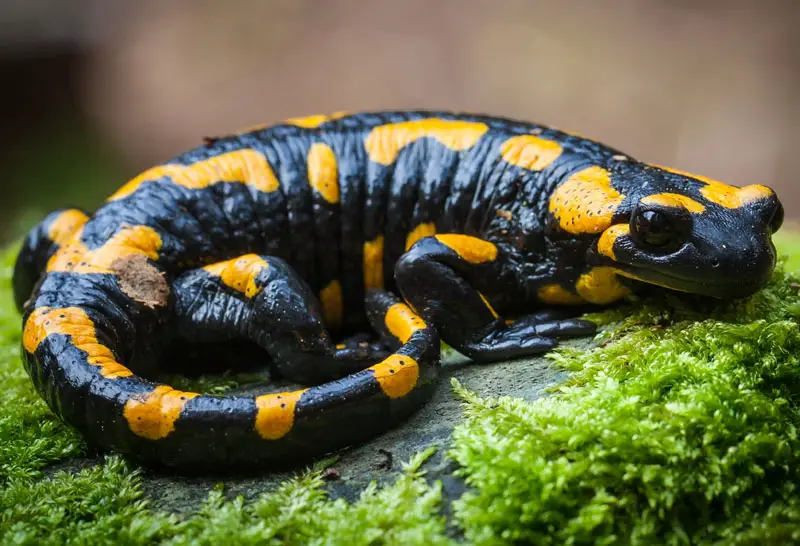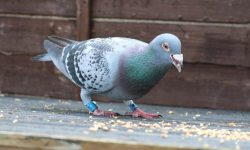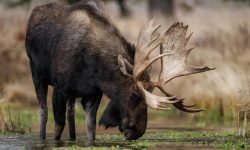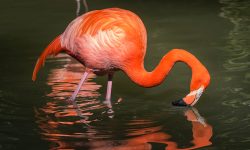Salamanders are fascinating amphibians found in forests, wetlands, mountains and underground habitats across the world. Their secretive nature means many people rarely see them, yet salamanders play essential roles in ecosystems by controlling insect populations and recycling nutrients. Understanding what salamanders eat helps reveal how they survive in damp, shaded places and why their diets are more diverse than many expect.
Most salamanders are carnivores, feeding on small animals they can swallow whole. Without teeth adapted for chewing, they rely on quick strikes, sticky tongues or ambush techniques to capture prey. Their diet changes depending on habitat, size and age. Some species hunt above ground at night, while others feed underwater or beneath leaf litter. Because salamanders live in environments where food availability fluctuates, they adapt by eating a wide range of invertebrates.
This guide explores 20 wild foods salamanders eat most, offering a deeper look at the small creatures that sustain them throughout the year and support their growth, reproduction and survival.
Understanding the Salamander Diet

Salamanders are strict carnivores, depending entirely on animal-based foods. Their hunting strategy involves stealth and patience. Many species hide beneath logs or moss, waiting for prey to crawl within reach. Others use rapid tongue projection to capture insects instantly. Aquatic species rely on suction feeding, snapping prey into their mouths using water pressure.
Their diet varies by life stage. Larval salamanders consume tiny aquatic organisms such as insect larvae and micro-crustaceans. As they grow, they shift to larger prey including worms, beetles and slugs. Adult salamanders must eat frequently to maintain moisture and energy levels, especially during active seasons like spring and early summer.
Because salamanders help regulate insect populations, their diet is tied directly to ecosystem health. A habitat rich in diverse invertebrates supports strong salamander populations, while degraded environments reduce available prey and threaten salamander survival.
20 Wild Foods Salamanders Eat Most
1. Earthworms
Earthworms are a staple food for many salamander species, especially those that forage on forest floors. Their soft bodies and high moisture content make them easy to swallow and digest.
Salamanders locate earthworms by sensing vibrations in the soil or by moving through moist leaf litter at night. Worms offer protein and hydration, both essential for maintaining healthy skin and energy stores.
After rainfall, earthworms rise to the surface, giving salamanders abundant feeding opportunities during peak activity periods.
2. Slugs
Slugs are slow-moving prey commonly found in damp environments where salamanders thrive. Their soft bodies make them ideal for salamanders that cannot chew.
Salamanders detect slugs by smell or by following slime trails across logs and soil. Despite their mucous coating, slugs provide valuable nutrients and moisture.
They become especially important during cool, wet periods when other invertebrates hide or become inactive.
3. Snails (Small)
Small snails offer additional calcium through their thin shells, which salamanders can partially crush or swallow depending on species size.
Salamanders typically target juvenile snails with softer shells. These prey items provide protein and essential minerals important for muscle function.
Snails are common in shaded, moist habitats, making them accessible year-round for many salamanders.
4. Beetles
Beetles appear in forests, grasslands and under logs, making them a common food. Their hard exoskeletons require salamanders to swallow them whole.
Salamanders ambush beetles by sitting motionless until the prey walks nearby. Their sticky tongues help secure beetles before escape.
Although harder to digest, beetles offer nutrient-dense meals rich in fats and proteins.
5. Beetle Larvae
Beetle larvae are softer and easier to digest than adult beetles. These larvae inhabit rotting wood, soil and leaf litter.
Salamanders search damp logs or loose bark to uncover larvae. Their slow movement makes them dependable prey for both juveniles and adults.
Larvae contain moisture and concentrated nutrients that support salamander growth and recovery after winter inactivity.
6. Ants
Ants occur in large colonies, giving salamanders access to consistent feeding opportunities. They forage for ants near soil cracks, rotting stumps or along forest trails.
Ants offer protein and minerals, though salamanders usually eat them in small quantities at a time. Their quick availability makes them helpful supplements during periods of low prey diversity.
Some salamanders specialize in feeding around ant-rich microhabitats to reduce foraging effort.
7. Termites
Termites thrive in decaying wood, which salamanders often explore while seeking shelter. Their soft bodies make them ideal prey.
Salamanders pick termites off exposed surfaces inside logs or capture them when colonies become active. Termites provide steady protein that sustains salamanders during warm seasons.
In forests with abundant fallen trees, termite-rich habitats support large salamander populations.
8. Spiders
Spiders supply moisture and protein, making them valuable prey. Salamanders hunt spiders by approaching quietly and striking rapidly.
Spiders hide under leaves, bark and stones—places salamanders explore regularly. Their availability throughout the year makes them a dependable food source.
Despite spiders’ defensive abilities, salamanders often overpower them using speed and stealth.
9. Mites and Small Arthropods
Tiny arthropods such as mites live within soil, moss and leaf litter. These micro-prey items are crucial for small juvenile salamanders.
Larval salamanders feed heavily on these tiny organisms during their early development. They require little energy to catch and can be consumed in large numbers.
Even adult salamanders may eat mites while foraging for larger prey, adding balance to their diet.
10. Springtails
Springtails thrive in moist leaf litter and decaying vegetation, forming dense populations. Their hopping behavior attracts salamanders’ attention.
Salamanders capture springtails using quick tongue flicks. These small creatures provide hydration and lightweight protein ideal for juveniles.
Springtails remain available during cool seasons when other insects slow down, making them dependable in temperate forests.
11. Crickets
Crickets offer higher protein content than many other insects, making them valuable for salamanders needing energy for mating or regeneration.
Wild salamanders hunt crickets at night when both species are active. Their movements stimulate salamanders to strike.
Crickets appear in many habitats, giving salamanders recurring opportunities to feed on them throughout warm months.
12. Grasshoppers (Small)
Small grasshoppers enter salamander diets when they venture near humid forest edges. Salamanders target younger or smaller individuals they can swallow.
Grasshoppers offer substantial protein, supporting growth in larger salamander species. Their unpredictable jumps trigger salamanders’ predatory instincts.
This prey is more seasonal, peaking during late summer in sunny clearings near salamander habitats.
13. Fly Larvae
Fly larvae live in wet soil, decaying material and near aquatic edges. Salamanders encounter them while exploring damp ground.
Larvae are soft, easy to digest and widely available in moist habitats. They help salamanders maintain hydration and nutrient intake during rainy periods.
Aquatic larvae also serve as food for salamander species that remain underwater throughout their lives.
14. Mosquito Larvae
Mosquito larvae float near the surface of ponds, puddles and wetlands. Aquatic salamanders use suction feeding to pull them in with water.
These larvae provide light protein suitable for juvenile salamanders and adults in early spring. Their abundance helps salamanders recover from winter fasting.
Mosquito-rich waters support high salamander densities by offering constant food.
15. Tadpoles (Very Small)
Some salamanders opportunistically eat tiny tadpoles when food is scarce or when they inhabit shared ponds.
Salamanders capture tadpoles with quick mouth movements or by cornering them along submerged vegetation. Tadpoles supply protein and hydration.
This behavior occurs mostly in aquatic salamander species and is influenced by seasonal availability.
16. Small Fish (For Larger Salamanders)
Large salamander species such as hellbenders or tiger salamanders sometimes capture small fish in streams or ponds.
These salamanders use ambush tactics, striking quickly from beneath rocks or submerged debris. Fish provide dense calories that help larger salamanders maintain body mass.
Although not eaten daily, fish become important when salamanders require extra energy.
17. Aquatic Insects
Dragonfly nymphs, mayfly larvae and other aquatic insects form key components of the diet for aquatic and semi-aquatic salamanders.
These insects live beneath stones or within submerged plants. Salamanders locate them using motion cues or scent trails.
Aquatic insects supply nutrients vital for salamanders that spend most of their lives underwater.
18. Worm Larvae and Soil Invertebrates
Tiny soil invertebrates such as nematodes and annelid larvae populate moist forest floors. Salamanders ingest them while foraging through leaf litter.
These microscopic organisms help salamanders maintain consistent nutrient intake, especially in early spring. They also support juvenile development.
Soil-rich environments with high organic matter allow salamanders to find these prey effortlessly.
19. Millipedes (Small Species)
Small millipedes are eaten by larger salamander species capable of handling mildly toxic or tough-bodied prey.
Salamanders disable millipedes with quick strikes, avoiding defensive secretions by swallowing them rapidly. Millipedes offer minerals and durable proteins.
They are common in damp logs and shaded soil, making them accessible during nighttime foraging.
20. Small Snakes or Amphibians (Rare Cases)
In rare circumstances, larger salamanders may consume tiny snakes, froglets or even smaller salamanders. This behavior occurs mainly in nutrient-poor habitats.
Ambush strategies allow salamanders to surprise these small vertebrates. While uncommon, these meals offer concentrated nutrients.
Such predation highlights the adaptability of salamanders when typical prey becomes limited.
FAQs About What Do Salamanders Eat
Are salamanders carnivores?
Yes. They eat only animal-based foods throughout their lives.
Do salamanders eat insects?
Insects make up the majority of the salamander diet.
Do salamanders eat worms?
Yes. Earthworms are among their most important food sources.
Do salamanders eat plants?
No. They cannot digest plant material.
What do baby salamanders eat?
Micro-invertebrates such as mites, springtails, mosquito larvae and tiny worms.
Do salamanders hunt at night?
Most species are nocturnal hunters.
Do aquatic salamanders eat different foods?
They eat aquatic insects, larvae, mosquito larvae and small fish.
How do salamanders catch prey?
Using fast strikes, sticky tongues or suction feeding.
Do salamanders eat spiders?
Yes. Spiders are common prey in forest habitats.
Do salamanders chew food?
No. They swallow prey whole.
Final Thoughts
Salamanders survive in a wide range of habitats because they are versatile carnivores capable of hunting insects, worms, aquatic larvae and other small animals. Their diet supports rapid growth, skin health and the energy needed for nocturnal activity. Understanding what salamanders eat highlights their importance in controlling insect populations and maintaining healthy ecosystems. These small amphibians may be elusive, but their feeding habits reveal just how vital they are to the natural world.






